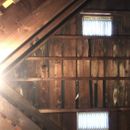Attic Spray Foam UV Protection
Hi
i have decided to have 3” of closed cell spray foam and 3” of mineral wool insulation installed at the underside of my roof sheathing and inside of table walls. This decision was made after determining I will want to install a gas furnace and potentially erv in the attic and want this equipment to operate in a conditioned space. I will close the gable wall vents with tyvek covered plywood and plan to install new siding on the outside in a year or so
I am concerned about UV protection for the spray at a small gap between the roof sheathing, purlins and gable walls. I think the gap is caused by the sheathing being installed on top of the purlins so there is a ~3/4” gap between the bottom of sheathing and the gable walls where there are no purlins
what do you recommend I do to close this gap? I have thought of the following, none of which seems like a great option as far as cost and time spent:
— backer rod and silicone caulk (seems labor intensive)
— aluminum backed flashing tape attached to the underside of the roof sheathing and gable walls https://www.homedepot.com/p/ProForce-Waterproof-Repair-Tape-8872AW6/305175238 (seems expensive/overkill)
— tyvek painted with some type of uv resistant paint stapled to the underside of sheathing and walls (not sure what paint to use)
— plywood filler strips attached to the gable walls (seems like a lot of work)
Greg
GBA Detail Library
A collection of one thousand construction details organized by climate and house part











Replies
Get a good exterior paint, have it tinted as black as they can tint it. Paint any exposed spray foam with a heavy coat of that black exterior paint. Black paint alone is a pretty good UV protectant. You don’t need anything special.
To give you a little context, the reason outdoor phone cables on poles are black is because the black pigment in the polyethylene outer jacket of the cables provides UV protection for the polyethylene polymer. These cables are expect to last 30 years in different direct exposure to sunlight, and they typically last much longer. The black pigment absorbs the UV light before it can damage the polymer chains in the polyethylene material.
Bill